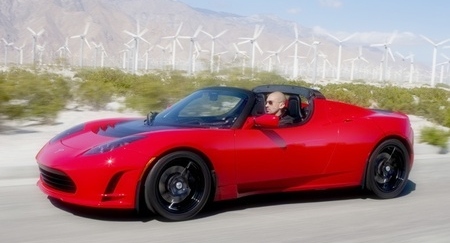No wonder the world is in a penurious state, if the example of Proton is anything to go by.
Proton, the Malaysian automaker that bought control of Lotus in 1996, has not made any profit from the British unit for 15 years and guesstimates are that it probably will remain in the red to at least until 2014.
 Tesla “Lotus”.
Tesla “Lotus”.
Just to complicate that, now it is rumored that Proton itself may be sold off by the government, with investors such as Gan Eng Peng saying Lotus Group International is ripe for a sale.
“It will make sense for them to sell it,” said Gan, adding, “Proton and Lotus are not a good fit. They are in different market segments, both in terms of geography and product.” Now that may be so on the surface, but let us not forget that Tata owns Jaguar these days, and that is an even greater disparity with trucks and pick-ups and luxury sports cars.
Lotus, which has struggled to compete against Porsche and Ferrari in Europe, has hung on to relevance in the auto industry partly because of its decades-long expertise in designing lightweight frames, However, the company may need the backing of an automaker more global (and more cashed up) than Proton to survive in an industry where carmakers such as Saab Automobile are filing for bankruptcy.
Two months ago, Proton denied a report by the Star newspaper that it was selling its Lotus stake to Luxembourg-based Genii Capital. That is interesting as Genii Capital was the main sponsor for the Lotus Renault F1 team.
Phil Gott, an IHS Automotive analyst specializing in powertrain research, agrees that Lotus technology is excellent. Expertise in making lightweight frames, a defining area of strength since its founding in 1952 by British engineer Colin Chapman, has allowed Lotus designs to be a popular option for electric cars, Gott said.
Tesla Motors has relied on Lotus chassis designs since 2008 for its $US 109,000 electric Roadster sports car. The Lotus Elise weighs 912 kilograms, making it the lightest performance car sold in the US, according to Santa Monica, California-based Edmunds.com. The 2012 Porsche Cayman is much heavier while the Mazda MX-5 Miata sports convertible also weighs much more.
Proton’s stock has gained 44 percent in Kuala Lumpur trading as speculation on its sale heated up. State-owned Khazanah Nasional Bhd., which holds a 43 percent stake in Proton, has since confirmed it has received offers. Khazanah officials have declined to comment on Proton’s sale, however, beyond saying it received proposals of interest. Sime Darby Motors, Naza Group, Hyundai-Berjaya, DRB-Hicom and UMW Holdings are reputedly candidates, though Sime and UMW have said they are not interested, but they might just be playing their cards close to their chest.
Former Malaysian Prime Minister Mahathir Mohamad, who founded Proton in 1983, said in December that billionaire Syed Mokhtar Al-Bukhary’s DRB-Hicom, an auto assembler, is the best candidate to buy the government stake and that Proton shouldn’t be sold to a foreign company. Recently, Proton has been looking at joint ventures with other manufacturers, such as GM and VW, but nothing was ever signed, sealed and delivered. For Proton, whose profit tumbled 76 percent in the last quarter, unloading Lotus may give it money to invest in production facilities as Malaysia’s national carmaker faces mounting domestic competition from Toyota and Perusahaan Otomobil Kedua (Perodua).
To be a viable entity, Lotus will have to sell 8000 vehicles a year, but last year the total was 1985 units, according to its annual report. Compare that with Ferrari, whose chairman said in September that it will probably post record sales of 7000 cars this year.
So who wants to buy a company which has lost money every year for the past 15 years, and no sign of that changing this year or next? You would have to be very brave.




